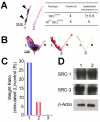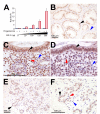Steroid receptor coactivator 2 is required for female fertility and mammary morphogenesis: insights from the mouse, relevance to the human
- PMID: 18174919
- PMCID: PMC2121321
- DOI: 10.1621/nrs.05011
Steroid receptor coactivator 2 is required for female fertility and mammary morphogenesis: insights from the mouse, relevance to the human
Abstract
Although the importance of the progesterone receptor (PR) to female reproductive and mammary gland biology is firmly established, the coregulators selectively co-opted by PR in these systems have not been clearly delineated. A selective gene-knockout approach applied to the mouse, which abrogates gene function only in cell types that express PR, recently disclosed steroid receptor coactivator 2 (SRC-2, also known as TIF-2 or GRIP-1) to be an indispensable coregulator for uterine and mammary gland responses that require progesterone. Uterine cells positive for PR (but devoid of SRC-2) were found to be incapable of facilitating embryo implantation, a necessary first step toward the establishment of the materno-fetal interface. Importantly, such an implantation defect is not exhibited by knockouts for SRC-1 or SRC-3, underscoring the unique coregulator importance of SRC-2 in peri-implantation biology. Moreover, despite normal levels of PR, SRC-1 and SRC-3, progesterone-dependent branching morphogenesis and alveologenesis fails to occur in the murine mammary gland in the absence of SRC-2, thereby establishing a critical coregulator role for SRC-2 in signaling cascades that mediate progesterone-induced mammary epithelial proliferation. Finally, the recent detection of SRC-2 in the human endometrium and breast suggests that this coregulator may represent a new clinical target for the future management of female reproductive health and/or breast cancer.
Figures




Similar articles
-
Steroid receptor coactivator 2 is critical for progesterone-dependent uterine function and mammary morphogenesis in the mouse.Mol Cell Biol. 2006 Sep;26(17):6571-83. doi: 10.1128/MCB.00654-06. Mol Cell Biol. 2006. PMID: 16914740 Free PMC article.
-
Steroid receptor coactivator 2: an essential coregulator of progestin-induced uterine and mammary morphogenesis.Ernst Schering Found Symp Proc. 2007;(1):55-76. doi: 10.1007/2789_2007_057. Ernst Schering Found Symp Proc. 2007. PMID: 18540568 Review.
-
Steroid receptor coactivator 2 is essential for progesterone-dependent uterine function and mammary morphogenesis: insights from the mouse--implications for the human.J Steroid Biochem Mol Biol. 2006 Dec;102(1-5):22-31. doi: 10.1016/j.jsbmb.2006.09.007. Epub 2006 Oct 12. J Steroid Biochem Mol Biol. 2006. PMID: 17045797 Review.
-
Progesterone-action in the murine uterus and mammary gland requires steroid receptor coactivator 2: relevance to the human.Front Biosci. 2007 May 1;12:3640-7. doi: 10.2741/2340. Front Biosci. 2007. PMID: 17485327 Review.
-
Steroid receptor coactivator (SRC)-1 and SRC-3 differentially modulate tissue-specific activation functions of the progesterone receptor.Mol Endocrinol. 2006 Jan;20(1):45-55. doi: 10.1210/me.2005-0310. Epub 2005 Sep 1. Mol Endocrinol. 2006. PMID: 16141356
Cited by
-
Nuclear receptor coactivators: master regulators of human health and disease.Annu Rev Med. 2014;65:279-92. doi: 10.1146/annurev-med-051812-145316. Epub 2013 Sep 16. Annu Rev Med. 2014. PMID: 24111892 Free PMC article. Review.
-
The members of bHLH transcription factor superfamily are required for female reproduction in the red flour beetle, Tribolium castaneum.J Insect Physiol. 2010 Oct;56(10):1481-9. doi: 10.1016/j.jinsphys.2010.03.005. Epub 2010 Mar 16. J Insect Physiol. 2010. PMID: 20223247 Free PMC article.
-
Mechanisms of implantation: strategies for successful pregnancy.Nat Med. 2012 Dec;18(12):1754-67. doi: 10.1038/nm.3012. Nat Med. 2012. PMID: 23223073 Free PMC article. Review.
-
Synergistic Regulation of Coregulator/Nuclear Receptor Interaction by Ligand and DNA.Structure. 2017 Oct 3;25(10):1506-1518.e4. doi: 10.1016/j.str.2017.07.019. Epub 2017 Sep 7. Structure. 2017. PMID: 28890360 Free PMC article.
-
Subfertility linked to combined luteal insufficiency and uterine progesterone resistance.Endocrinology. 2010 Sep;151(9):4537-50. doi: 10.1210/en.2010-0440. Epub 2010 Jul 21. Endocrinology. 2010. PMID: 20660062 Free PMC article.
References
-
- Anzick S. L., Kononen J., Walker R. L., Azorsa D. O., Tanner M. M., Guan X. Y., Sauter G., Kallioniemi O. P., Trent J. M., Meltzer P. S. AIB1, a steroid receptor coactivator amplified in breast and ovarian cancer. Science. 1997;277:965–8. - PubMed
-
- Belandia B., Parker M. G. Functional interaction between the p160 coactivator proteins and the transcriptional enhancer factor family of transcription factors. J Biol Chem. 2000;275:30801–5. - PubMed
Publication types
MeSH terms
Substances
Grants and funding
LinkOut - more resources
Full Text Sources
Research Materials
Miscellaneous

